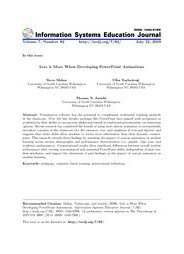Volume 7
Volume 7, Number 82 |
July 22, 2009 |
Abstract: Presentation software has the potential to complement traditional teaching methods in the classroom. Over the last decade, packages like PowerPoint have gained wide acceptance in academia for their ability to incorporate additional stimuli in traditional presentations via animation options. Recent research has considered the benefit of using such custom animation to incrementally introduce concepts in the classroom (for the entrance, exit, and emphasis of text and figures) and suggests that static slides allow students to retain more information than their dynamic counterparts. This research extends those findings by assessing the impact of custom animation on student learning across various demographic and performance characteristics (i.e., gender, class year, and academic performance). Computational results show significant differences between overall student performance after viewing non-animated and animated PowerPoint slides, independent of most student attributes, and suggest the robustness of past findings on the impact of custom animation on student learning.
Keywords: pedagogy, computer based training, instructional technology
Download this issue: ISEDJ.7(82).Mahar.pdf (Adobe PDF, 11 pages, 568 K bytes)
Preview the contents: Mahar.j.txt (ASCII txt, 23 K bytes)
Recommended Citation: Mahar, Yaylacicegi, and Janicki (2009). Less is More When Developing PowerPoint Animations. Information Systems Education Journal, 7 (82). http://isedj.org/7/82/. ISSN: 1545-679X. (A preliminary version appears in The Proceedings of ISECON 2008: §3115. ISSN: 1542-7382.)
